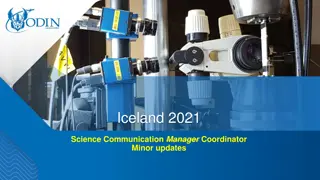
Hydrometeorology and the Water Cycle
Explore the field of hydrometeorology, its importance, applications, and the intriguing processes of the water cycle. Learn about the transfer of water and energy in the lower atmosphere, forecasting techniques, and the essential role of the water cycle in sustaining life on Earth.
Download Presentation

Please find below an Image/Link to download the presentation.
The content on the website is provided AS IS for your information and personal use only. It may not be sold, licensed, or shared on other websites without obtaining consent from the author. If you encounter any issues during the download, it is possible that the publisher has removed the file from their server.
You are allowed to download the files provided on this website for personal or commercial use, subject to the condition that they are used lawfully. All files are the property of their respective owners.
The content on the website is provided AS IS for your information and personal use only. It may not be sold, licensed, or shared on other websites without obtaining consent from the author.
E N D
Presentation Transcript
Introduction of the HYDROMETEOROLOGY DR.IQBAL KHALAF
Definition of hydrometeorology Definition of hydrometeorology Hydrometeorology is a branch of meteorology and hydrology that studies the transfer of water and energy between the land surface and the lower atmosphere. UNESCO has several programmers and activities in place that deal with the study of natural hazards of hydro meteorological origin and the mitigation of their effects. Among these hazards are the results of natural processes or phenomena of atmospheric, Hydrological or oceanographic nature such as floods, tropical cyclones, drought and desertification Importance and applications of hydrometeorology This book describes recent developments in hydro meteorological forecasting, with a focus on water-related applications of meteorological observation and forecasting techniques. The topic includes a wide range of disciplines, such as rain gauge, weather radar, satellite, and river and other monitoring techniques, rainfall-runoff, flow routing and hydraulic models, and now casting and Numerical Weather Prediction.
Applications include :- 1- flood forecasting 2- drought forecasting 3- climate change impact assessments 4- reservoir management 5- water resources 6- water quality studies.
WATER CYCLE WATER CYCLE The water cycle, also known as the hydrological cycle, describes the continuous movement of water on, above and below the surface of the Earth. The division of water varies depending on the wide range of climatic variables where Tim divides it into: - 1-ice 2- fresh water 3- saline water 4- atmospheric water Water travels from one reservoir to another, such as from a river to the ocean, or from the ocean to the atmosphere through physical processes that include all of the following 1- evaporation 2- condensation 3-precipitation
4-infiltration 5- surface runoff 6- and subsurface flow The water when it passes through these processes will go through a number of different stages, including both:- 1- liquid 2-solid (ice) 3- vapor. The water cycle includes an energy exchange, which leads to temperature changes, for example: When water evaporates, it takes energy from its surroundings, leading to the environment being cooled. And when it condenses, it releases energy and warms the surrounding environment Both of these evaporation and condensation processes are causing heat exchanges on the climate where they work. 1- The steam cycle phase purifies water and thus feeds the earth with liquid fresh water and minerals transported across the globe.
2-It is also involved in the reconfiguration of the Earth's geological features, through processes including corrosion and sedimentation. 3-The water cycle is also necessary to preserve most of the life and ecosystems on the planet.






















